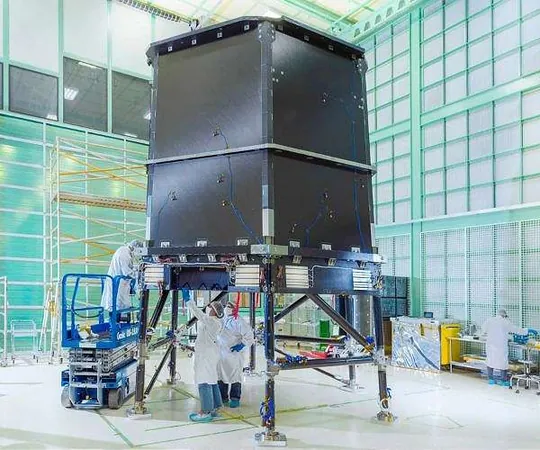
NASA's Roman Space Telescope Passes Crucial Centrifuge Test - Here’s What It Means for Space Exploration!
2024-10-10
Author: Rajesh
NASA's Nancy Grace Roman Space Telescope Completes Major Test
NASA's Nancy Grace Roman Space Telescope has recently completed a significant spinning test at the Goddard Space Flight Center in Greenbelt, Maryland. This test is a crucial step in its mission to expand our understanding of the universe. The component put to the test was the Outer Barrel Assembly—vital for regulating temperature and shielding the telescope from unwanted light.
The Testing Process
The two-part test took place in an expansive, specialized chamber where a massive 600,000-pound steel arm rotated a segment of the telescope. This sophisticated procedure was akin to a carnival ride, applying centrifugal forces at speeds of up to 18.4 rotations per minute, creating gravitational forces exceeding seven times that of Earth, which equals roughly 80 miles per hour.
Components of the Outer Barrel Assembly
Due to its impressive size—standing 17 feet (5 meters) tall and spanning 13.5 feet (4 meters) wide—the Outer Barrel Assembly had to be tested in segments. Jay Parker, the product design lead for the assembly at Goddard, explained how they tackled this challenge by testing the assembly's two main components separately: the 'stilts' and the 'house.'
The 'Stilts' and 'House' Explained
The 'stilts,' known as the elephant stand, supports the telescope and connects its upper portion to the spacecraft bus, which is responsible for maneuvering the observatory into space. To replicate the entire assembly’s weight during testing, significant weights were added to the elephant stand.
Following this, the team turned their attention to the 'house,' which envelops the telescope's main instruments. This component will be outfitted with heaters aimed at guarding against extreme temperature fluctuations, which could distort the telescope's mirrors.
Design Features of the Outer Barrel Assembly
The design of the Outer Barrel Assembly emphasizes lightweight and rigid structures essential for space travel. Made from a composite of two carbon fibers and reinforced plastic, this assembly also features titanium fittings. Notably, the material incorporates a honeycomb structure between its inner and outer panels, providing exceptional strength while minimizing weight.
Future Testing and Merging Components
Created at Goddard and constructed by Applied Composites in California, the assembly underwent crane-assisted assembly in Goddard's largest clean room. After this test, the component will be reassembled and integrated with the telescope's solar panels and Deployable Aperture Cover by the end of the year.
Looking ahead, the integrated parts will undergo thermal vacuum testing in 2025, simulating the extreme conditions of space. A shake test will follow to ensure they withstand the launch vibrations before being combined with the entire observatory system.
Conclusion: A Step Towards the Future of Space Exploration
The Roman Space Telescope is set to revolutionize our understanding of the cosmos by investigating dark energy and exoplanets. Its successful series of tests not only propels this ambitious project forward but also fuels excitement in the astronomical community and beyond. Stay tuned for more updates on this groundbreaking mission that aims to unlock the secrets of the universe!


 Brasil (PT)
Brasil (PT)
 Canada (EN)
Canada (EN)
 Chile (ES)
Chile (ES)
 España (ES)
España (ES)
 France (FR)
France (FR)
 Hong Kong (EN)
Hong Kong (EN)
 Italia (IT)
Italia (IT)
 日本 (JA)
日本 (JA)
 Magyarország (HU)
Magyarország (HU)
 Norge (NO)
Norge (NO)
 Polska (PL)
Polska (PL)
 Schweiz (DE)
Schweiz (DE)
 Singapore (EN)
Singapore (EN)
 Sverige (SV)
Sverige (SV)
 Suomi (FI)
Suomi (FI)
 Türkiye (TR)
Türkiye (TR)